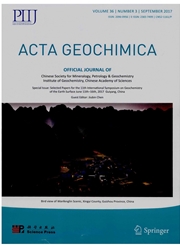

 中文摘要:
中文摘要:
在南部的 Shaanxi 省的 Jinlongshan 金矿带在 Qinling collisional orogenic 包含很多张巫婆类型金矿床。他们的液包体具有 Na~+-Cl~- 类型。从到以后的舞台上演的主要 metallogenic,为液包体的阴离子和阳离子,温度和 deoxidation 参数(R) 的全部的数量都逐渐地减少了,建议液体氧化, metallogenicdepth 的减小和天落水和器官的部件的输入的渐渐的增强。存款在外壳的高举期间被形成并且因此有类似的构造背景到 orogenic 金矿床。矿石液体的 CO_2contents 和 CO_2/H_2O 价值增加了从早,到迟了的阶段,和 thewall 岩石,改变被 decarbonation 代表,它与 orogenic 的特征不一致金矿床。它也被发现那 Na~+ , K~+ , SO_4~(2-) , Cl~-- 并且在在石英的包括的阴离子和阳离子的全部的数量比在共存的方解石的那些高。H, 0 并且 C 同位素比显示矿石液体从天落水和招待矿石的沉积岩的变形 devolatilisation 被采购。墙岩石的高背景δ~( 18 ) O 和δ ~( 13 ) C 价值导致了 O 和δ ~( 13 ) C 矿石液体和也高的δ ~( 18 ) O 和δ ~( 13 ) C 价值珍视的高δ ~( 18 )象石英和碳酸盐那样的热水的矿物质。在矿石液体的碳主要源于招待阶层。C Fe 方解石和液包体的δ D 价值珍视的δ ~(18 ) O 和δ ~(13 ) 是比方解石和石英的那些低的。以配位化学的理论,相反,所有这些差别能在一样的液体系统被归功于到水岩石相互作用到矿石液体的多来源。
 英文摘要:
英文摘要:
The Jinlongshan gold ore belt in southern Shaanxi Province contains a number of Carlin-type gold deposits in the Qinling collisional orogenic belt. Their fluid inclusions are of the Na^+ - Cl^- type. From the main metallogenic stage to later stages, the total quantity of anions and cations, temperature and deoxidation parameter (R) for fluid inclusions all gradually decreased, suggesting the gradual intensification of fluid oxidation, the reduction of metallogenic depth and the input of meteoric water and organic components. The deposits were formed during crustal uplifting and hence had similar tectonic settings to orogenic gold deposits. The CO2 contents and CO2/H2O values of the ore fluid increased from early to late stages, and the wall-rock alteration is represented by decarbonation, which is inconsistent with the characteristics of orogenic gold deposits. It is also discovered that Na^+, K^+ , SO^2-4, Cl^- and the total amounts of anions and cations in the inclusions in quartz are higher than those in the coexisting calcite. The H2 O and C isotope ratios indicate that the ore fluid was sourced from meteoric water and metamorphic devolatilisation of the sedimentary rocks that host the ores. The high background δ^18O and 8 δ^13C values of wall rocks resulted in high δ^18O and δ^13C values of ore fluid and also high δ^18O and δ^13C values of hydrothermal minerals such as quartz and carbonate. The carbon in ore fluid stemmed largely from the hosting strata. The δ^18O and δ^13C values of Fe-calcite and the 8D values of fluid inclusions are lower than those of calcite and quartz. In terms of the theory of coordination chemistry, all these differences can be ascribed to water-rock interaction in the same fluid system, instead, to the multisource of ore fluid.
 同期刊论文项目
同期刊论文项目
 同项目期刊论文
同项目期刊论文
 Isotope systematics and fluid inclusion studies of the Qiyugou breccia pipe-hosted gold deposit, Qin
Isotope systematics and fluid inclusion studies of the Qiyugou breccia pipe-hosted gold deposit, Qin The Shanggong Gold Deposit, Eastern Qinling Orogen, China: Isotope Geochemistry and Implications for
The Shanggong Gold Deposit, Eastern Qinling Orogen, China: Isotope Geochemistry and Implications for Geology and D-O-C isotope systematics of the Tieluping silver deposit, Henan, China: Implications fo
Geology and D-O-C isotope systematics of the Tieluping silver deposit, Henan, China: Implications fo Comparison of the typical metallogenic systems in the north slope of the Tongbai-East Qinling Mounta
Comparison of the typical metallogenic systems in the north slope of the Tongbai-East Qinling Mounta Isotope geochemistry of the Weishancheng stratabound gold-silver ore belt, Tongbai County, Henan Pro
Isotope geochemistry of the Weishancheng stratabound gold-silver ore belt, Tongbai County, Henan Pro Origin of gold metallogeny and sources of ore-forming fluids, in the Jiaodong province, eastern Chin
Origin of gold metallogeny and sources of ore-forming fluids, in the Jiaodong province, eastern Chin Ore geology, fluid geochemistry and genesis of the Shanggong gold deposit, eastern Qinling Orogen, C
Ore geology, fluid geochemistry and genesis of the Shanggong gold deposit, eastern Qinling Orogen, C 期刊信息
期刊信息
